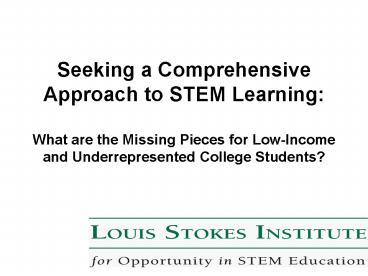Seeking a Comprehensive Approach to STEM Learning: - PowerPoint PPT Presentation
1 / 14
Title:
Seeking a Comprehensive Approach to STEM Learning:
Description:
... Pipeline from 9th Grade to Bachelor's Degree for. Low-Income Students in ... (1) Thomas Mortenson, postsecondary.org, Bachelor's Degree Attainment by Age 24 ... – PowerPoint PPT presentation
Number of Views:39
Avg rating:3.0/5.0
Title: Seeking a Comprehensive Approach to STEM Learning:
1
Seeking a Comprehensive Approach to STEM
Learning
- What are the Missing Pieces for Low-Incomeand
Underrepresented College Students?
2
STEM Pipeline from 9th Grade to Bachelors Degree
in the U.S.
10,000 Students Start the 9th Grade
2,400 of 10,000 Students Earn a Bachelors
Degree 400 BA/BS in STEM Fields
5.900 of 10,000 Students Go to College 800 are
Declared STEM Majors
8,200 of 10,000 Students Earn a High
School Diploma
3
STEM Pipeline from 9th Grade to Bachelors Degree
for Low-Income Students in the U.S.
10,000 Students in the Bottom Income
Quartile Start the 9th Grade
6,600 of 10,000 Students Earn a High
School Diploma
3,860 of 10,000 Students Go to College 76 are
Declared STEM Majors
710 of 10,000 Students Earn a Bachelors
Degree 30 BA/BS in STEM Fields
4
What is Happening to Low-Income College Students
in STEM?
5
First-Year Experience Low-Income Students
Declared STEM Majors
- Students who have completed four or more years of
mathematics - Only 19.8 are low-income
- Students who have completed Calculus
- Only 16.6 are low-income
- Students who took a remedial math course
- Only 22 are low-income
6
First-Year Experience Low-Income Students
Declared STEM Majors
- Approximately 1 sought out academic support
- Approximately 50 of the students reporting to
have to work more hours or get another job were
low-income
7
First-Year Experience Low-Income Students
Declared STEM Majors
- Most likely to sometimes or never meet with an
advisor - Most likely to sometimes or never talk to faculty
- Do not feel socially integrated in the campus
community
8
First-Year Outcome First-Year GPA
- Low-Income STEM Majors
- 64 below 3.00
- GPA Range 0.00-1.99
- 27 of the students
- GPA Range 2.00-2.99
- 37 of the students
- GPA Range 3.00-4.00
- 36 of the students
9
What is happening to Low-Income Students in STEM?
- How we define achievement and scholarship in STEM
10
What is happening to Low-Income Students in STEM?
- Students start the first day of college in
financial debt - Students start the first day of college in
academic debt
11
How does academic debt occur?
- Notions of achievement and scholarship in
mathematics in preparing for college - Problems manifest itself in the first-year course
taking and performance - Problems compounded by financial debt
- Problems compounded by institutional response to
students
12
Path to Changing the College Experience for
Low-Income Students in STEM
- Paradigm shift on how we define achievement and
scholarship in STEM - With Corresponding Research and Coordinating
Organization
13
Policies, Research and Strategies
- Institutional Change in Higher Education
- Administration
- Academic
- Professional Development
- Student Support
14
Sources and Notes
- (1) Thomas Mortenson, postsecondary.org,
Bachelors Degree Attainment by Age 24 by Family
Income Quartiles , 1970 to 2005 - (2) U.S. Department of Education, National Center
for Education Statistics, 199596 Beginning
Postsecondary Students Longitudinal Study, Second
Follow-up (BPS96/01) - (3) U.S. Department of Education, National Center
for Education Statistics, 2001 Baccalaureate and
Beyond Longitudinal Study (BB2000/01). - Notes To establish a comparative and continuous
cohort, the following cohorts were used the
95-96 cohort from BPS96/01 the 99-00 cohort
from BB 2000/01 and the 1996 cohort from
Bachelors Degree Attainment by Age 24 by Family
Income Quartiles , 1970 to 2005. Calculated by
Kailikole, K., The Stoke Institute, 2008.































